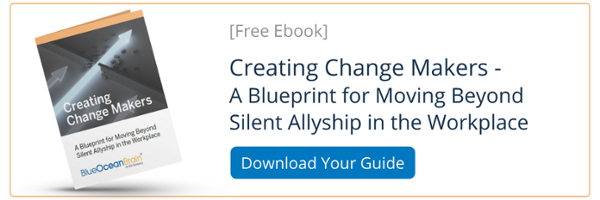Over the past few years, a new C-suite role has emerged—CDO, or Chief Diversity Officer. They are responsible for helping companies further their diversity, equity, and inclusion (DEI) efforts. And there is no doubt it is an important one. But just because companies have a person in this high-level position does not mean that person is solely responsible for DEI. Who else is? Everybody.
DEI is not the sole responsibility of the CDO, HR, or senior leaders. Yes, they play an essential part in setting the stage and culture for supporting DEI. But everyone in the organization needs to play an active role.
That is where employees come into play.
Employees as active allies
An ally commits to creating a culture of inclusion and actively helps to advance others through positive efforts. Active allies put their words and intentions into practice. It is one thing to say you support DEI; it is another to show that you do through your words and deeds.
As the author of the Harvard Business Review article Be a Better Ally points out:
“We view allyship as a strategic mechanism used by individuals to become collaborators, accomplices, and co-conspirators who fight injustice and promote equity in the workplace through supportive personal relationships and public acts of sponsorship and advocacy.”
Consider the power your organization would have to support a strong DEI culture if every one of your employees was an active ally. Here are some actionable ways employees can champion DEI across their teams and the organization.
Speak Up
One of the best ways employees can be active allies is to speak up when they observe something that may marginalize a member of some group—or when they witness bias. Employees can also point out policies or practices that may be discriminatory or exclusive—suggesting new sources for recruiting diverse candidates during the hiring process, for instance.
Establishing an environment where this type of feedback is welcomed and encouraged can help even those hesitant to make waves feel comfortable pointing out potential inequities.
Seek out—and stamp out—unconscious bias
Keep in mind that many forms of bias are unconscious, and pointing out instances where bias is unintentional can create powerful learning opportunities. Even seemingly minor things like who tends to clean up the breakroom (often women in most organizations) can be an issue ripe for a correction.
Many biases derive from us not knowing what we do not know. Obviously, this can make it easy for us to fail to see our personal bias even though our intentions may be positive and strong. Those with this awareness can serve as active allies in helping others who understand why DEI matters and are committed to having a positive impact but do not know how they may be acting on their own unconscious biases.
.png?width=600&name=unnamed%20(2).png)
Actively advocate
Through teams, whether for business or social functions, employees can advocate for the inclusion of members of various marginalized groups to ensure they are represented and have opportunities to interact with others and be recognized.
Such as observing a team with no female representation and piping up: “You know, I just realized we do not have any women on our team. I think X would be a great addition to this group.”
Or take the form of recommending others for opportunities or speaking positively and sharing examples of their impacts and successes.
Reach out to be inclusive
Every day employees have numerous opportunities to either include or exclude others. In the workplace, that might be as simple as asking someone to join a lunch group or seeking the opinion of someone in a meeting who has not contributed.
These efforts are even more critical in a remote or hybrid environment. It is even easier for employees to be marginalized in a virtual world if someone is not actively inviting, including, and reaching out to them.
HR and L&D leaders are in a great position to share these ideas with employees to provide them with some specific examples and actions they can take to be active DEI allies. Even better, incorporating learning that normalizes inclusive behaviors and offers actionable ideas for how employees can level up their allyship can go a long way in building strong support for DEI.
How you can help develop active allies
First, be explicit about the role of an active ally. Tell them what it means and share some examples of specific, actionable things they can do, as outlined above.
Education and skill-building also are ways to help employees become active allies. Arm employees with information and examples. Providing information in small, easily digestible bites—microlearning—can be an extremely effective way to ensure employees take advantage of the information available and easily refer to brief snippets of information when they need a refresher or have a question.
Arm your employees with the information, tools, and resources they need to be active allies. It is a powerful way to create and sustain a strong DEI culture.
Looking for more tips on building your DEI culture?
Do you need actionable steps to encourage your leaders and staff to meet DEI initiatives? Moving beyond talk to action requires an innovative strategy—and we got you covered. Check out our new ebook, Creating Change Makers - A Blueprint for Moving Beyond Silent Allyship in the Workplace.





